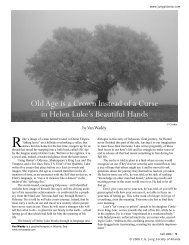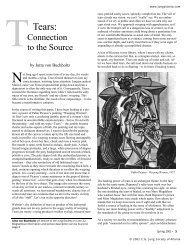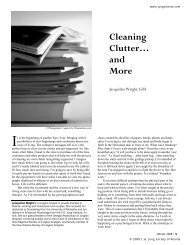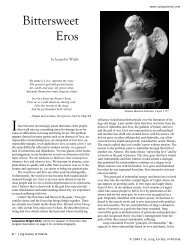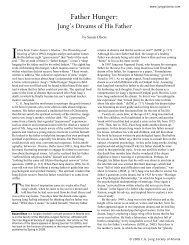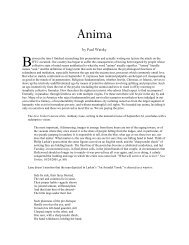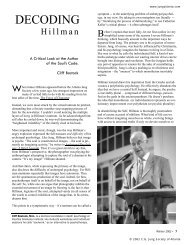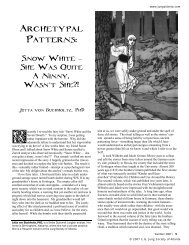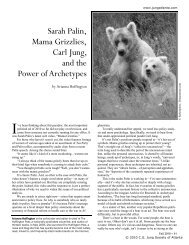Hermes and the Creation of Space - C.G. Jung Society of Atlanta
Hermes and the Creation of Space - C.G. Jung Society of Atlanta
Hermes and the Creation of Space - C.G. Jung Society of Atlanta
Create successful ePaper yourself
Turn your PDF publications into a flip-book with our unique Google optimized e-Paper software.
The Greek God<br />
<strong>Hermes</strong> <strong>and</strong> <strong>the</strong> <strong>Creation</strong> <strong>of</strong> <strong>Space</strong><br />
by Murray Stein<br />
Who was <strong>Hermes</strong>? The great 19th century German mythographer, W.H.Roscher,<br />
identified <strong>Hermes</strong> as <strong>the</strong> wind, subsuming under this basic identity all <strong>of</strong> his o<strong>the</strong>r roles<br />
<strong>and</strong> attributes - <strong>Hermes</strong> as servant <strong>and</strong> messenger <strong>of</strong> <strong>the</strong> sky god Zeus, <strong>Hermes</strong> as swift<br />
<strong>and</strong> winged, <strong>Hermes</strong> as thief <strong>and</strong> b<strong>and</strong>it, <strong>Hermes</strong> as inventor <strong>of</strong> <strong>the</strong> pipes <strong>and</strong> lyre, <strong>Hermes</strong> as<br />
guide <strong>of</strong> souls <strong>and</strong> as god <strong>of</strong> dreams <strong>and</strong> sleep, <strong>Hermes</strong> as promoter <strong>of</strong> fertility among plants <strong>and</strong><br />
animals <strong>and</strong> as patron <strong>of</strong> health, <strong>Hermes</strong> as god <strong>of</strong> good fortune, <strong>Hermes</strong> as patron <strong>of</strong> traffic <strong>and</strong><br />
business activities on water <strong>and</strong> l<strong>and</strong>. Ingeniously, Roscher tied all <strong>of</strong> <strong>the</strong>se functions to <strong>the</strong><br />
primitive perception <strong>of</strong> a wind god. <strong>Hermes</strong> is like <strong>the</strong> wind. We can hear Shelley's "Ode to <strong>the</strong><br />
West Wind" as a moving hymn to this god:<br />
O wild West Wind, thou breath <strong>of</strong> Autumn's being,<br />
Thou, from whose unseen presence <strong>the</strong> leaves dead<br />
Are driven, like ghosts from an enchanter fleeing...<br />
Norman O. Brown took up <strong>the</strong> scholarly quest for <strong>the</strong> essence <strong>of</strong> this enchanter in his classic work,<br />
first published in 1947, <strong>Hermes</strong> <strong>the</strong> Thief. Brown does not mention wind, or any o<strong>the</strong>r natural<br />
elements ei<strong>the</strong>r for that matter, but instead focuses on <strong>the</strong> human features <strong>of</strong> this complex Greek<br />
diety. Brown locates <strong>the</strong> core <strong>of</strong> <strong>Hermes</strong> in his stealth <strong>and</strong> his magic. <strong>Hermes</strong> was generally<br />
known in <strong>the</strong> ancient world as amoral <strong>and</strong> <strong>the</strong> patron god <strong>of</strong> thieves, highwaymen, travelers <strong>and</strong><br />
traders, <strong>and</strong> businessmen. In <strong>the</strong> famous portrait <strong>of</strong> him given in <strong>the</strong> Homeric Hymn, <strong>Hermes</strong> is a<br />
merry <strong>and</strong> light-hearted trickster figure. More than a simple robber or trickster, however, Brown<br />
sees in <strong>Hermes</strong> <strong>the</strong> figure <strong>of</strong> a magician. From his magical powers flow his o<strong>the</strong>r functions <strong>and</strong><br />
attributes. In Brown's brilliant account, <strong>Hermes</strong> is not meteorological but psychological, a human<br />
type, a shamanic presence.<br />
<strong>Hermes</strong> role as psychopomp is well-known too, <strong>and</strong> emphasized by Kerenyi in his essay on this<br />
god. This deepens <strong>the</strong> image. <strong>Jung</strong> adverts to this identity <strong>of</strong> <strong>Hermes</strong> in his references to <strong>Hermes</strong><br />
Kyllenios: "<strong>Hermes</strong> is <strong>the</strong> psychon aitios, 'originator <strong>of</strong> souls,'" he writes (1969, par. 538). Perhaps<br />
one can trace a symbolic link between Brown's shamanic-magical <strong>Hermes</strong> <strong>and</strong> Roscher's wind god<br />
<strong>Hermes</strong> in <strong>the</strong> linguistic fact that wind <strong>and</strong> spirit have <strong>the</strong> same name in Greek: pneuma.<br />
In <strong>the</strong> cluster <strong>of</strong> stories involving <strong>Hermes</strong> passed down in Greek tradition <strong>and</strong> literature, a distinct<br />
type <strong>of</strong> human character shines through: a young man <strong>of</strong> ideal physical build, extroverted, swift in<br />
physical movement <strong>and</strong> rhetorically gifted, enchanting <strong>and</strong> seductive, ready to serve but not to be<br />
taken advantage <strong>of</strong>, friendly but independent, inventive, intelligent, generally benign <strong>and</strong> having a<br />
ready sense <strong>of</strong> humor, athletic, stealthy. In art <strong>and</strong> story he is usually depicted as a puer aeternus,<br />
along <strong>the</strong> lines written by M.L. von Franz in her book on this <strong>the</strong>me. In mythic tales he is not at<br />
<strong>the</strong> center <strong>of</strong> politics, decision-making or narrative action, but on <strong>the</strong> periphery: "Mercury stirring<br />
up <strong>the</strong> broth <strong>of</strong> air at <strong>the</strong> edge/ Of Botticelli's Spring," to use John Holl<strong>and</strong>er's fine words<br />
("Looking Ahead"). <strong>Hermes</strong> st<strong>and</strong>s at <strong>the</strong> edge, an edge-person, located essentially in liminality.<br />
"<strong>Hermes</strong>' original home was not at <strong>the</strong> center but on <strong>the</strong> edge <strong>of</strong> things, on <strong>the</strong> boundary," notes<br />
Brown (p.113). The fa<strong>the</strong>r principle is relatively weak <strong>and</strong> absent in <strong>Hermes</strong> (he is a bastard son <strong>of</strong><br />
Zeus who fell in love momentarily with <strong>the</strong> nymph Maia), while <strong>the</strong> mo<strong>the</strong>r is positive <strong>and</strong> doting.<br />
This puer aeternus has <strong>the</strong> airy swift spirit <strong>of</strong> <strong>the</strong> wind <strong>and</strong> <strong>the</strong> intelligence <strong>and</strong> a skill <strong>of</strong> a<br />
magician.
<strong>Hermes</strong> as Archetypal Image<br />
What is <strong>Hermes</strong>? Wind, magic, a puer spirit. But beyond that, he is a god, <strong>and</strong> to fathom what this<br />
means we need to plunge deeper into <strong>the</strong> connections between this mythic image <strong>and</strong> <strong>the</strong><br />
archetypal <strong>and</strong> instinctual base <strong>of</strong> <strong>the</strong> psyche from which he comes <strong>and</strong> which he represents. Why<br />
is he an immortal god? Where is his numinosity?<br />
Brown points out what many o<strong>the</strong>r scholars say as well, that <strong>the</strong> "name <strong>Hermes</strong> is probably<br />
derived from <strong>the</strong> Greek word for 'stone-heap,' herma, <strong>and</strong> signifies 'he <strong>of</strong> <strong>the</strong> stone-heap'" (p. 33).<br />
Martin Nilsson, in his delightful little book, Greek Folk Religion, imagines a peasant walking<br />
through <strong>the</strong> Greek countryside. He writes:<br />
If our peasant passed a heap <strong>of</strong> stones, as he was likely to do,<br />
he might lay ano<strong>the</strong>r stone upon it. If a tall stone was erected on<br />
top <strong>of</strong> <strong>the</strong> heap, he might place before it a bit <strong>of</strong> his provision as<br />
an <strong>of</strong>fering. He performed this act as a result <strong>of</strong> custom, without<br />
knowing <strong>the</strong> real reason for it, but he knew that a god was<br />
embodied in <strong>the</strong> stone heap <strong>and</strong> in <strong>the</strong> tall stone st<strong>and</strong>ing on top<br />
<strong>of</strong> it. He named <strong>the</strong> god <strong>Hermes</strong> after <strong>the</strong> stone heap (herma) in<br />
which he dwelt, <strong>and</strong> he called <strong>the</strong> tall stone a herm. Such heaps<br />
were welcome l<strong>and</strong>marks to <strong>the</strong> w<strong>and</strong>erer who sought his way<br />
from one place to ano<strong>the</strong>r through desert tracts, <strong>and</strong> <strong>the</strong>ir god<br />
became <strong>the</strong> protector <strong>of</strong> wayfarers. And if, by chance, <strong>the</strong> wayfarer<br />
found on <strong>the</strong> stone heap something, probably an <strong>of</strong>fering, which<br />
would be welcome to <strong>the</strong> poor <strong>and</strong> hungry, he ascribed this lucky<br />
find to <strong>the</strong> grace <strong>of</strong> <strong>the</strong> god <strong>and</strong> called it a hermaion. (p. 8)<br />
The name <strong>Hermes</strong> is connected with <strong>the</strong> name for <strong>the</strong> stone heap that was a boundary-marker, a<br />
herma. This is <strong>the</strong> physical fact from which <strong>the</strong> experience <strong>of</strong> <strong>Hermes</strong> springs, in which it is<br />
grounded. Around this concrete phenomenon <strong>of</strong> <strong>the</strong> boundary-marker <strong>the</strong>re grew up <strong>the</strong> many<br />
associated features <strong>and</strong> qualities that go into making this god what he is. Something about <strong>the</strong><br />
experience <strong>of</strong> herma <strong>and</strong> boundaries <strong>and</strong> cross-roads stimulated <strong>the</strong> Greek imagination into<br />
elaborating <strong>the</strong> figure <strong>of</strong> <strong>Hermes</strong>.<br />
Nilsson continues his imaginative presentation by saying that this stone heap at <strong>the</strong> crossroads<br />
might have marked a grave, <strong>and</strong> perhaps <strong>the</strong>re was a body buried under it. This would mark a<br />
space that was a crossroad in a double sense, with one axis horizontal, ano<strong>the</strong>r vertical: A threedimensional<br />
cross-roads. <strong>Hermes</strong> is a god <strong>of</strong> travelers living <strong>and</strong> dead, his monument <strong>of</strong> stones a<br />
boundary marker for <strong>the</strong> world on this plane <strong>and</strong> between it <strong>and</strong> <strong>the</strong> underworld. Kerenyi, in his<br />
masterful study, <strong>Hermes</strong>, Guide <strong>of</strong> Souls, emphasizes <strong>the</strong> god's role in traversing <strong>the</strong> boundary<br />
between life <strong>and</strong> death, between this world <strong>and</strong> <strong>the</strong> underworld <strong>of</strong> shades, Hades. Because <strong>of</strong> his<br />
association with boundaries <strong>and</strong> with <strong>the</strong> realm <strong>of</strong> shades, <strong>Hermes</strong> takes on <strong>the</strong> features <strong>of</strong> a<br />
liminal god, or <strong>of</strong> what I have called a god <strong>of</strong> liminality in my book In MidLife, that is, one who<br />
inhabits interstices, a denizen <strong>of</strong> betwixt-<strong>and</strong>-between (cf. Turner). He st<strong>and</strong>s at <strong>the</strong> edge not only<br />
geographically <strong>and</strong> interpersonally but also metaphysically. He is essentially in <strong>and</strong> <strong>of</strong> <strong>the</strong> world <strong>of</strong><br />
liminality.<br />
The element <strong>of</strong> uncanniness, which Walter Otto so forcefully stresses in his chapter on <strong>Hermes</strong> in<br />
The Homeric Gods, would attach to <strong>Hermes</strong> because <strong>of</strong> this close association with <strong>the</strong> spirits <strong>of</strong><br />
<strong>the</strong> dead <strong>and</strong> <strong>the</strong> underworld. The Oxford Classical Dictionary states flatly that while <strong>Hermes</strong><br />
appears as a youth, he "...is probably one <strong>of</strong> <strong>the</strong> oldest [<strong>of</strong> <strong>the</strong> gods] <strong>and</strong> most nearly primitive in<br />
origin....<strong>and</strong> signifies <strong>the</strong> daemon who haunts or occupies a heap <strong>of</strong> stones, or perhaps a stone, set<br />
up by <strong>the</strong> roadside for some magical purpose" (pp.502-3). Again, we come upon <strong>the</strong> notion <strong>of</strong><br />
magic in connection with <strong>Hermes</strong>.
The classic statue <strong>of</strong> <strong>Hermes</strong>, called a Herm, was a later development. It was a quadratic pillar<br />
usually about 6 feet high resting on a square base, topped with a bearded head <strong>and</strong> fronted with an<br />
erect phallus. Herms first appeared under rule <strong>of</strong> <strong>the</strong> tyrant Hipparchus around 520-524 B.C., who<br />
had <strong>the</strong>se figures set up as boundary markers throughout Greece. Oddly, <strong>the</strong> Herm has none <strong>of</strong> <strong>the</strong><br />
qualities <strong>of</strong> movement <strong>and</strong> lightness usually associated with <strong>the</strong> spirit <strong>of</strong> <strong>Hermes</strong>, <strong>and</strong> <strong>the</strong> head<br />
atop it is that <strong>of</strong> an older, bearded man. It is anything but youthful, dynamic <strong>and</strong> air-like, although<br />
it is quite charming in its own way. A marker <strong>of</strong> boundaries, it is geometric <strong>and</strong> hard-edged, exact<br />
<strong>and</strong> defining. Hipparchus set <strong>the</strong>se in place, according to Brown, in order to "integrate <strong>the</strong> cult <strong>of</strong><br />
<strong>Hermes</strong> into urban <strong>and</strong> political life <strong>of</strong> <strong>the</strong> city-state" (p. 113). This brought <strong>Hermes</strong> more centrally<br />
into Greek consciousness. A Herm was also placed at <strong>the</strong> Propyleia (entrance) to sacred precincts<br />
<strong>and</strong> temples, where he marked <strong>the</strong> boundary <strong>of</strong> <strong>the</strong> temenos. With this development, liminality<br />
moved in closer to centrality; everywhere <strong>Hermes</strong> now stood at boundaries <strong>and</strong> defined spaces,<br />
referring <strong>the</strong> citizen to horizontal <strong>and</strong> vertical dimensions <strong>of</strong> existence.<br />
Archetypally, we can see in <strong>the</strong> image <strong>of</strong> <strong>Hermes</strong> a mythical statement <strong>of</strong> <strong>the</strong> psyche's innate<br />
tendency to give definition to perceptual <strong>and</strong> mental horizons, to mark edges, to define spaces.<br />
Originally <strong>Hermes</strong> stood at <strong>the</strong> edge <strong>of</strong> known space, a pile <strong>of</strong> stones at <strong>the</strong> boundary. His sign<br />
marked <strong>the</strong> limit <strong>of</strong> consciousness. Beyond <strong>the</strong> boundary lies <strong>the</strong> unknown, <strong>the</strong> uncanny, <strong>the</strong><br />
dangerous, <strong>the</strong> unconscious. When markers are created <strong>and</strong> limits set, however, curiosity <strong>and</strong><br />
explorativeness are also excited <strong>and</strong> new spaces for exploration <strong>and</strong> discovery invite <strong>the</strong> bold <strong>and</strong><br />
courageous traveler. If <strong>Hermes</strong> marks <strong>the</strong> boundary between conscious <strong>and</strong> unconscious, we have<br />
to realize that this boundary is always shifting <strong>and</strong> in flux; it is mercurial. Background <strong>and</strong><br />
foreground may instantaneously reverse too, <strong>and</strong> generate new perceptions, novel insights.<br />
Within <strong>the</strong> area <strong>of</strong> <strong>the</strong> known, containers take shape which are reserved for specific types <strong>of</strong><br />
human activity, while beyond <strong>the</strong>m lies <strong>the</strong> "o<strong>the</strong>r," <strong>the</strong> foreign (even if only temporarily), <strong>the</strong><br />
taboo, <strong>the</strong> forbidden, <strong>the</strong> unclean. <strong>Hermes</strong> st<strong>and</strong>ing at <strong>the</strong> boundary marks a psychological <strong>and</strong><br />
sometimes a moral limit <strong>and</strong> calls special attention to <strong>the</strong> space being entered or left. When he first<br />
appears, he may create a new space by dividing a vast horizon into <strong>the</strong> "here" <strong>and</strong> <strong>the</strong> "beyond,"<br />
<strong>and</strong> thus he creates both consciousness <strong>and</strong> a new unconscious. His intervention in <strong>the</strong> perceptual<br />
<strong>and</strong> psychological field creates new possibilities for consciousness, also new edges <strong>and</strong> boundaries<br />
beyond which lie <strong>the</strong> mysterious "o<strong>the</strong>rs." When he disappears, <strong>the</strong>re is a loss <strong>of</strong> identity <strong>and</strong><br />
definition.<br />
Boundaries, it must be noted, are basic to human perception, <strong>and</strong> <strong>the</strong>ir creation <strong>and</strong> maintenance<br />
<strong>the</strong>refore are archetypal. Boundaries create categories for thought <strong>and</strong> behavior. Fences not only<br />
make good neighbors; fences make neighbors, period. Without boundaries <strong>the</strong>re are no object<br />
relations - in a sense <strong>the</strong>re are no objects; without definitions <strong>the</strong>re can be no thought; <strong>the</strong> world is<br />
ouboboric, undifferentiated, pleromatic. The appearance <strong>of</strong> herma - an epiphany <strong>of</strong> <strong>Hermes</strong> -<br />
represents <strong>the</strong> introduction <strong>of</strong> <strong>the</strong> differentiating principle into <strong>the</strong> pleromatic void.<br />
In Seven Sermons to <strong>the</strong> Dead (1989, pp. 378-90), <strong>Jung</strong> calls this principle creatura, <strong>the</strong> principle<br />
<strong>of</strong> distinctiveness:<br />
Distinctiveness is creatura. It is distinct. Distinctiveness is its essence, <strong>and</strong> <strong>the</strong>refore it<br />
distinguisheth. Therefore man discriminateth because his nature is distinctiveness.... Our very<br />
nature is distinctiveness....<strong>the</strong> natural striving <strong>of</strong> <strong>the</strong> creature goeth towards distinctiveness,<br />
fighteth against primeval, perilous sameness. This is called <strong>the</strong> PRINCIPIUM<br />
INDIVIDUATIONIS. This principle is <strong>the</strong> essence <strong>of</strong> <strong>the</strong> creature.<br />
<strong>Hermes</strong> is <strong>the</strong> psyche etching lines into <strong>the</strong> panes <strong>of</strong> perception.<br />
What does it add to say that this function <strong>of</strong> making distinctions is archetypal <strong>and</strong> not simply an<br />
artifact <strong>of</strong> ego-functioning? It says that <strong>the</strong> ego actually depends upon <strong>the</strong> psyche in order to
function properly. By keeping <strong>Hermes</strong> out <strong>of</strong> <strong>the</strong> ego <strong>and</strong> refusing to make him ego-syntonic, we<br />
acknowledge our dependency upon archetypal powers even for our most mundane daily activities.<br />
In <strong>the</strong> agora <strong>and</strong> not only at a crossroads in <strong>the</strong> wilderness, at home <strong>and</strong> not only at <strong>the</strong> gate <strong>of</strong> <strong>the</strong><br />
sacred temenos, <strong>Hermes</strong> is present. The archetypes undergird <strong>the</strong> ego in all <strong>of</strong> its activities <strong>and</strong><br />
functions. This is a key to perceiving sacredness in everyday life.<br />
<strong>Hermes</strong> <strong>and</strong> <strong>the</strong> Instinct <strong>of</strong> Creativity<br />
The erect phallus on <strong>Hermes</strong> monuments has perplexed scholars <strong>and</strong> amused tourists. Burkert says<br />
that a "form <strong>of</strong> territorial demarcation, older than man himself, is phallic display, which is <strong>the</strong>n<br />
symbolically replaced by erected stones or stakes. To this extent, stone cairn <strong>and</strong> apotropaic<br />
phallos have always gone toge<strong>the</strong>r" (1985 p. 156). Burkert, who seems to be a keen student <strong>of</strong><br />
animal behavior <strong>and</strong> ethological studies, connects <strong>the</strong> phallicism <strong>of</strong> Herms to <strong>the</strong> phallic display <strong>of</strong><br />
a certain species <strong>of</strong> monkeys: "...<strong>the</strong>y sit up at <strong>the</strong> outposts, facing outside <strong>and</strong> presenting <strong>the</strong>ir<br />
erect genital organ.... every individual approaching from <strong>the</strong> outside will notice that this group<br />
does not consist <strong>of</strong> helpless wives <strong>and</strong> children, but enjoys <strong>the</strong> full protection <strong>of</strong> masculinity"<br />
(1982, p. 40).<br />
To me this emphasis on <strong>Hermes</strong>' protective role <strong>and</strong> on <strong>the</strong> use <strong>of</strong> Herms to br<strong>and</strong>ish claims <strong>of</strong><br />
territoriality seems interesting but far-fetched. It is one thing to say that <strong>Hermes</strong> st<strong>and</strong>s at<br />
boundaries <strong>and</strong> defines space; it is quite ano<strong>the</strong>r to make <strong>of</strong> him a guardian <strong>of</strong> <strong>the</strong> gate. This is not<br />
usually seen to be his role. Cerberus guards <strong>the</strong> gates <strong>of</strong> Hades, not <strong>Hermes</strong>. And Apollo would be<br />
insulted to realize that one supposed <strong>Hermes</strong> was needed to guard <strong>the</strong> gates <strong>of</strong> his sacred precincts<br />
on Delos. <strong>Hermes</strong> is a thief, not a guard. Burkert has to admit: "That a monument <strong>of</strong> this kind<br />
could be transformed into an Olympian god is astounding" (1985, p. 156).<br />
The answer is <strong>of</strong> course that <strong>Hermes</strong> was a god long before <strong>the</strong> Herm was constructed. He is<br />
archaic <strong>and</strong> primordial. But so is territory <strong>and</strong> <strong>the</strong> sense <strong>of</strong> territoriality. Yet it was not <strong>Hermes</strong>'<br />
management <strong>of</strong> <strong>the</strong> territorial imperative that placed him on Olympus. It was his connection to <strong>the</strong><br />
source <strong>of</strong> life, to archetype <strong>and</strong> instinct, to <strong>the</strong> self. <strong>Hermes</strong> states creativity. It seems to me that a<br />
better explanation for <strong>the</strong> presence <strong>of</strong> <strong>the</strong> erect phallos on <strong>Hermes</strong>' monuments has to do with his<br />
deep <strong>and</strong> indeed essential association with <strong>the</strong> instinct <strong>of</strong> creativity.<br />
Creativity is highlighted in a number <strong>of</strong> tales <strong>and</strong> emphasized by some scholars as a major<br />
attribute <strong>of</strong> this god. Along with Hephaistos <strong>and</strong> Prome<strong>the</strong>us, <strong>Hermes</strong> was loved <strong>and</strong> honored by<br />
craftsmen. The sheer rampant energy <strong>of</strong> creativity sounds through <strong>the</strong> image <strong>of</strong> <strong>Hermes</strong> as he is<br />
classically presented in <strong>the</strong> Homeric Hymn. In <strong>the</strong> Hymn to <strong>Hermes</strong> we hear <strong>of</strong> <strong>the</strong> new-born baby<br />
creating <strong>the</strong> lyre from a tortoise shell on <strong>the</strong> first day <strong>of</strong> his life. Later he is credited with <strong>the</strong><br />
discovery <strong>of</strong> starting fire by rubbing sticks toge<strong>the</strong>r <strong>and</strong> with <strong>the</strong> invention <strong>of</strong> <strong>the</strong> pipes. The sheer<br />
joy <strong>and</strong> delight he experiences at his own quick <strong>and</strong> sure inventiveness are infectious as one reads<br />
or listens to <strong>the</strong> Hymn. This has reminded some readers <strong>of</strong> <strong>the</strong> gleam in <strong>the</strong> craftsman's eye as he<br />
forges a new device or solves a practical problem (cf. Brown, p. 79). You can hear this joyous<br />
craftsman's energy in Wagner's rendition <strong>of</strong> Siegried hammering his sword into shape in <strong>the</strong> third<br />
opera <strong>of</strong> <strong>the</strong> Ring cycle.<br />
After his successful struggle with Apollo to attain equal rank - interpreted to represent <strong>the</strong> rise <strong>of</strong><br />
craftsmen in ancient Greece <strong>and</strong> <strong>the</strong>ir seizure <strong>of</strong> equality with <strong>the</strong> aristocracy <strong>of</strong> A<strong>the</strong>ns (cf.<br />
Brown, pp.79ff.) - <strong>Hermes</strong> is given equality in <strong>the</strong> arts with Apollo, <strong>the</strong> great god <strong>of</strong> poetry, music,<br />
dance <strong>and</strong> o<strong>the</strong>r artistic activities in ancient Greece. <strong>Hermes</strong> claims in <strong>the</strong> Hymn that he is a<br />
follower <strong>of</strong> Mnemosyne, <strong>the</strong> goddess <strong>of</strong> memory, <strong>and</strong> her daughters <strong>the</strong> Muses (hence his<br />
appearance in Botticelli's famous painting, Spring). His essential association with <strong>the</strong> instinct <strong>of</strong><br />
creativity must be granted.
Brown draws an important distinction, too, when he points out that <strong>Hermes</strong> is not primarily a<br />
fertility god. The phallos on his statue is not a signifier <strong>of</strong> male procreativity <strong>and</strong> sexual prowess.<br />
Brown associates <strong>the</strong> phallos with his perception that <strong>Hermes</strong> is fundamentally a magician: "The<br />
phallus is so closely identified with magic in Roman religion that <strong>the</strong> word fascinum, meaning<br />
'enchantment,' 'witchcraft' (cf. 'fascinate'), is one <strong>of</strong> <strong>the</strong> st<strong>and</strong>ard Latin terms for <strong>the</strong> phallus; no<br />
better evidence could be found for <strong>the</strong> appropriateness <strong>of</strong> <strong>the</strong> emblem for <strong>Hermes</strong> as magician.<br />
When Greek craftsmen hung images <strong>of</strong> ithyphallic demons over <strong>the</strong>ir workshops, it is clear that to<br />
<strong>the</strong>m <strong>the</strong> phallus symbolized not fertility but magic skill at craftsmanship" (p. 37). I would agree<br />
with Brown but place <strong>the</strong> accent on creativity - <strong>the</strong> Creative itself as fascinosum, following Aniela<br />
Jaffe's interpretation <strong>of</strong> <strong>Jung</strong>'s famous childhood dream <strong>of</strong> <strong>the</strong> underground phallus - ra<strong>the</strong>r than on<br />
magic, although <strong>the</strong> two can easily be associated. Creative people have <strong>of</strong>ten seem especially<br />
potent <strong>and</strong> magical, <strong>and</strong> <strong>the</strong>ir talents can be awesome <strong>and</strong> numinous. Creativity is magical, <strong>of</strong> <strong>the</strong><br />
self <strong>and</strong> not <strong>of</strong> <strong>the</strong> ego.<br />
The phallos on <strong>the</strong> <strong>Hermes</strong> monument, <strong>the</strong>n, grounds this image in instinct, not in <strong>the</strong> sexual<br />
instinct as such however but in <strong>the</strong> instinct <strong>of</strong> creativity.<br />
<strong>Hermes</strong> as a "factor" in <strong>the</strong> psyche<br />
In my underst<strong>and</strong>ing <strong>of</strong> <strong>Jung</strong>'s mature thought, a major mythic figure like a god represents a<br />
psychological factor that embraces an archetype <strong>and</strong> an instinct. The archetype, rooted ultimately<br />
in spirit, is represented in <strong>the</strong> psyche by an image <strong>and</strong> is a mental, <strong>and</strong> <strong>of</strong>ten a cognitive, object or<br />
process; <strong>the</strong> instinct, rooted in <strong>the</strong> material body, is experienced in <strong>the</strong> psyche as an urge, a drive, a<br />
force compelling one to do something. In <strong>the</strong> psychological factor that a god symbolizes, instinct<br />
supplies <strong>the</strong> drive <strong>and</strong> <strong>the</strong> dynamic force, while image orients <strong>and</strong> directs it. Instinct <strong>and</strong> archetype<br />
are wedded in <strong>the</strong> psyche, <strong>and</strong> a god is a representation <strong>of</strong> this conjunction.<br />
To summarize what I have said so far about <strong>the</strong> Greek god <strong>Hermes</strong>: in <strong>Hermes</strong> we have a figure<br />
who signifies a union between an innate tendency on <strong>the</strong> part <strong>of</strong> <strong>the</strong> psyche to create boundaries<br />
<strong>and</strong> define spaces, to etch lines in <strong>the</strong> panes <strong>of</strong> perception (an archetypal process), <strong>and</strong> <strong>the</strong> instinct<br />
<strong>of</strong> creativity. It is this particular combination <strong>of</strong> archetype <strong>and</strong> instinct that makes <strong>Hermes</strong> so<br />
interesting psychologically. He signifies <strong>the</strong> creative instinct at work in <strong>the</strong> psyche in a particular<br />
way. A specific type <strong>of</strong> creator god, he is <strong>the</strong> creator <strong>of</strong> new spaces. It is in <strong>the</strong> creation <strong>of</strong> new<br />
spaces, novel spaces, inventive spaces, especially psychologically subtle spaces that <strong>Hermes</strong><br />
shows his special nature <strong>and</strong> genius. Trickster <strong>and</strong> magician are suitable epi<strong>the</strong>ts, for <strong>of</strong>ten <strong>the</strong>se<br />
are secret spaces <strong>of</strong> subtle interiority.<br />
New <strong>Space</strong>s<br />
When you draw a line on a blank page, you create new space. And you also destroy or transform<br />
an already existing space. In this simple act, destruction <strong>and</strong> creation take place <strong>and</strong> a new space is<br />
opened up. A new inside/outside possibility has been created, as when some people are elected to<br />
form a small group within a larger group. Yahweh, ano<strong>the</strong>r creator god, resembles <strong>Hermes</strong> in this<br />
respect; he too creates space, divides <strong>and</strong> sets boundaries, <strong>and</strong> selects a people from among all <strong>the</strong><br />
peoples <strong>of</strong> <strong>the</strong> earth to be his chosen.<br />
Some spaces have magical properties, which unite inside <strong>and</strong> outside in a surprising way, like <strong>the</strong><br />
Moebius strip. Boundaries are not what <strong>the</strong>y seem. Even carefully guarded <strong>and</strong> maintained, <strong>the</strong>y<br />
are both real <strong>and</strong> irreal. It is as though <strong>the</strong> boundary line is a space itself, which can open into a<br />
new space <strong>and</strong> which is permeable to <strong>the</strong> o<strong>the</strong>r spaces. This is <strong>Hermes</strong> space, a liminal space.<br />
Boundaries, we find again <strong>and</strong> again, both separate <strong>and</strong> unite spaces.
What <strong>Jung</strong> called "<strong>the</strong> reality <strong>of</strong> <strong>the</strong> psyche" or "<strong>the</strong> objective psyche" is such a category. The<br />
psyche has boundaries, but <strong>the</strong>y are both real <strong>and</strong> irreal. They are boundary lines that exp<strong>and</strong> into<br />
liminal spaces <strong>the</strong>mselves. At <strong>the</strong> boundary <strong>of</strong> psyche <strong>the</strong>re is a psychoid area, psyche-like but not<br />
limited to subjectivity; it is both inside <strong>and</strong> outside <strong>of</strong> <strong>the</strong> psyche. <strong>Jung</strong>'s notion <strong>of</strong> <strong>the</strong> objective<br />
psyche embraces a space that is beyond <strong>the</strong> usual subject-object, inner-outer dichotomy <strong>and</strong><br />
includes parapsychological phenomena <strong>and</strong> synchronicity (for an incisive discussion <strong>of</strong> this, cf.<br />
von Franz, 1990, chapter 9). Can we think <strong>of</strong> <strong>Hermes</strong> as being <strong>the</strong> archetypal image embedded in<br />
<strong>Jung</strong>'s notion <strong>of</strong> <strong>the</strong> reality <strong>of</strong> <strong>the</strong> psyche? Was <strong>Jung</strong> really a child <strong>of</strong> <strong>Hermes</strong>? I think a good case<br />
can be made for this.<br />
The <strong>Space</strong> <strong>of</strong> Psycho<strong>the</strong>rapy<br />
Perhaps we can leap now over two or three thous<strong>and</strong> years <strong>of</strong> history <strong>and</strong> look at <strong>the</strong> creation <strong>of</strong><br />
novel psychological spaces in <strong>the</strong> twentieth century. I want to refer, initially at least, to <strong>the</strong><br />
creation <strong>of</strong> <strong>the</strong> space <strong>of</strong> psycho<strong>the</strong>rapy in our present <strong>and</strong> fast-closing century, <strong>and</strong> to see this as an<br />
artifact <strong>of</strong> <strong>the</strong> <strong>Hermes</strong> archetype.<br />
Psycho<strong>the</strong>rapy exists in <strong>and</strong> depends upon <strong>the</strong> creation <strong>of</strong> a space that is a new space <strong>and</strong> yet one<br />
that does not violate <strong>the</strong> boundaries <strong>of</strong> o<strong>the</strong>r already established spaces. It is a space that opens in<br />
<strong>the</strong> boundary line between public <strong>and</strong> private, pr<strong>of</strong>essional <strong>and</strong> personal. It is a space that <strong>of</strong>ten has<br />
magical properties reflective <strong>of</strong> <strong>the</strong> reality <strong>of</strong> <strong>the</strong> psyche, in that synchronicity <strong>and</strong><br />
parapsychological phenomena are <strong>of</strong>ten constellated in this space. Winnicott wrote <strong>of</strong> <strong>the</strong> kind <strong>of</strong><br />
space I will describe as transitional space, but I do not much care for <strong>the</strong> term. Transitional to<br />
what? has been my question. I prefer to call it "a third space."<br />
What kind <strong>of</strong> a space is this? Is <strong>the</strong>re a <strong>the</strong>rapist alive who has not been struck by <strong>the</strong> frequency <strong>of</strong><br />
<strong>the</strong> feeling <strong>and</strong> <strong>the</strong> fantasy <strong>of</strong> <strong>the</strong>rapy as a love affair? Not an illicit love affair, because <strong>of</strong>ten <strong>the</strong><br />
spouse knows <strong>and</strong> apparently approves <strong>of</strong> it, <strong>and</strong> it takes place in <strong>the</strong> full light <strong>of</strong> day - taxes,<br />
insurance, <strong>of</strong>fice hours, answering machines, <strong>and</strong> all <strong>the</strong> paraphernalia <strong>of</strong> <strong>of</strong>ficial business life.<br />
And yet, a married (or unmarried) woman leaves her home (or <strong>of</strong>fice) <strong>and</strong> comes to my place at a<br />
certain hour <strong>of</strong> <strong>the</strong> afternoon once a week, full <strong>of</strong> excitement <strong>and</strong> expectation, having prepared<br />
herself emotionally <strong>and</strong> physically for this intimate encounter. She may hesitate as she pays <strong>and</strong><br />
say that she somehow doesn't feel it's right to give money for this, nor does she want to<br />
acknowledge that this is not a purely personal relationship on both sides. What a strange<br />
relationship this is, she may remark; so personal <strong>and</strong> intimate, <strong>and</strong> yet so removed from reality.<br />
The analyst knows so much about <strong>the</strong> patient, <strong>the</strong> patient so little about <strong>the</strong> analyst.<br />
Taking <strong>the</strong> fee, <strong>the</strong> analyst may feel a bit uncomfortable too, wondering if he is somehow illicitly<br />
involved in a subtle form <strong>of</strong> prostitution: selling his time <strong>and</strong> attention for a set fee, on a time<br />
schedule, at his place.<br />
But this is only <strong>the</strong> beginning, <strong>the</strong> surface. For constellated within <strong>the</strong> container <strong>of</strong> <strong>the</strong> analytic<br />
sessions is a third space, a psychic world unto itself yet existing within <strong>the</strong> given world <strong>of</strong><br />
convention, law <strong>and</strong> o<strong>the</strong>r relationships, <strong>and</strong> a world that recognizes its own limitations, its<br />
boundaries whose violation is absolutely taboo. This world opens up, or is created, by <strong>the</strong> mutual<br />
interplay <strong>of</strong> <strong>the</strong> psyches within it, which represent two o<strong>the</strong>r worlds, two persons with full lives<br />
outside <strong>of</strong> this new space. There is <strong>the</strong>refore a duality within this new space, each side <strong>of</strong> which<br />
has connections strongly fixed to <strong>the</strong> worlds outside <strong>of</strong> this one.<br />
This third space <strong>of</strong> <strong>the</strong>rapy dare not become One World, <strong>the</strong> Prime World, <strong>the</strong> only real space, or it<br />
will lose its st<strong>and</strong>ing in <strong>the</strong> world <strong>of</strong> solid boundaries, <strong>and</strong> this would create psychic confusion <strong>and</strong><br />
harm, even collapse. For this is a new <strong>and</strong> fragile space. And yet this space must also insist on its<br />
own legitimacy, its own right to exist, its own birthright <strong>and</strong> equality with o<strong>the</strong>r already<br />
established worlds. Here in <strong>the</strong> twentieth century experience <strong>of</strong> deep psycho<strong>the</strong>rapy we find a
eplay <strong>of</strong> <strong>the</strong> ancient story <strong>of</strong> <strong>the</strong> birth <strong>of</strong> <strong>Hermes</strong> <strong>and</strong> his rivalry with a bro<strong>the</strong>r, Apollo, who was<br />
already established <strong>and</strong> claimed a lot <strong>of</strong> space for himself. The third space, a new space, is a<br />
<strong>Hermes</strong> space.<br />
Depth psycho<strong>the</strong>rapy is a <strong>Hermes</strong> space in ano<strong>the</strong>r respect as well: it connects <strong>the</strong> upper world<br />
with <strong>the</strong> underworld, <strong>the</strong> world <strong>of</strong> shades <strong>and</strong> dreams, <strong>the</strong> unconscious. In <strong>the</strong> famous diagram that<br />
<strong>Jung</strong> drew <strong>of</strong> <strong>the</strong> analytic relationship, he showed a fur<strong>the</strong>r complication within this third space.<br />
There are four dimensions within it: 1. consc. to consc. (horizontal); 2. consc. to unc. (vertical); 3.<br />
unc. to consc. (diagonal); 4. unc. to unc. (horizontal). It is a quadratic relationship. Of <strong>the</strong> four<br />
vectors, <strong>the</strong> fourth is <strong>the</strong> most fascinating, for it is this one that represents <strong>the</strong> underground<br />
connection <strong>and</strong> implies <strong>the</strong> field <strong>of</strong> mutuality that defies <strong>the</strong> laws <strong>of</strong> time <strong>and</strong> space, inner <strong>and</strong><br />
outer, mine <strong>and</strong> yours. Out <strong>of</strong> this ground comes a force <strong>and</strong> a form that will define <strong>the</strong> quality <strong>of</strong><br />
<strong>the</strong> interactive field in each unique analytic relationship. It is here that we look for <strong>the</strong> epiphany <strong>of</strong><br />
new archetypes, mediated by <strong>the</strong> messenger god, <strong>Hermes</strong>, <strong>the</strong> creator <strong>of</strong> this new space. Here,<br />
within <strong>the</strong> third space <strong>of</strong> analysis, is yet ano<strong>the</strong>r third space that bridges <strong>and</strong> includes <strong>the</strong> duality <strong>of</strong><br />
<strong>the</strong> personalities involved in this complex field <strong>of</strong> vectors. Like <strong>Hermes</strong> crossroad-markers,<br />
psycho<strong>the</strong>rapy marks a double crossroad, horizontally in relation to <strong>the</strong> civic world <strong>and</strong> vertically<br />
in relation to <strong>the</strong> psychic world.<br />
Let me give a somewhat whimsical example <strong>of</strong> how this constellation <strong>of</strong> a third space manifests<br />
itself in clinical practice. A young man came to me recently for <strong>the</strong>rapy because he was stuck in<br />
his life <strong>and</strong> quite seriously depressed. After several sessions in which we became acquainted, more<br />
or less (vectors 1,2,3), he had a dream in which he was in bed with a well-known but now<br />
somewhat dated movie star. The dream went on to portray some <strong>of</strong> his personal conflicts <strong>and</strong><br />
problems in a humorous <strong>and</strong> graphic way, but <strong>the</strong> extraordinary detail that I noted in <strong>the</strong> dream<br />
was <strong>the</strong> identity <strong>of</strong> <strong>the</strong> movie star. I asked <strong>the</strong> young man whose dream this was for his<br />
associations to her, but he had none to speak <strong>of</strong>, o<strong>the</strong>r than some movies he had seen many years<br />
ago. He had not thought <strong>of</strong> her consciously in a long time <strong>and</strong> could hardly even remember her<br />
name after he woke up <strong>and</strong> was recording <strong>the</strong> dream.<br />
The strange <strong>and</strong> remarkable fact was that I had seen this very movie star in a restaurant only<br />
several months previously. She may be <strong>the</strong> only movie star I have ever seen up close (to my<br />
knowledge). What this dream told me was that vector 4 was activated, that <strong>Hermes</strong> was active. He<br />
would create a unique interactive field between us. A new space was being created.<br />
I could go on for a long time with similar examples from my own clinical experience <strong>and</strong> from <strong>the</strong><br />
practices <strong>of</strong> colleagues <strong>and</strong> supervisees who have shared <strong>the</strong>ir experiences with me over <strong>the</strong> past<br />
twenty years, each <strong>of</strong> which would illustrate <strong>the</strong> activation <strong>of</strong> this fourth dimension. This is <strong>the</strong><br />
uncanny element in analysis, that such things can <strong>and</strong> do happen in this highly protected, private,<br />
<strong>and</strong> confidential space. It is a space that is maximally sealed <strong>of</strong>f from <strong>the</strong> world <strong>and</strong> yet so<br />
pr<strong>of</strong>oundly open to it at ano<strong>the</strong>r level.<br />
Active Imagination<br />
<strong>Jung</strong>ian analysis classically uses two major methods: dream analysis <strong>and</strong> active imagination. Both<br />
<strong>of</strong> <strong>the</strong>se activities encourage <strong>the</strong> constellation <strong>of</strong> <strong>Hermes</strong> <strong>and</strong> <strong>the</strong> creation, or manifestation, <strong>of</strong> a<br />
"third space" in analysis. Active imagination, however, is an activity that is undertaken in solitude,<br />
by oneself, ra<strong>the</strong>r than in <strong>the</strong> presence <strong>of</strong> ano<strong>the</strong>r. It works on <strong>the</strong> vertical axis (#2) ra<strong>the</strong>r than <strong>the</strong><br />
horizontal, <strong>and</strong> its function is to consellate a third psychic space within <strong>the</strong> individual.<br />
Again we can see <strong>Jung</strong> as a child <strong>of</strong> <strong>Hermes</strong> as he embraces this method <strong>and</strong> refines it during his<br />
midlife years. As he tells <strong>the</strong> story <strong>of</strong> his discovery <strong>of</strong> active imagination as a method to promote<br />
individuation <strong>and</strong> to engage <strong>the</strong> unconscious, <strong>Jung</strong> entered this psychic geography for <strong>the</strong> first<br />
time with considerable fear <strong>and</strong> trepidation:
It was like a voyage to <strong>the</strong> moon, or a descent into empty space.<br />
First came <strong>the</strong> image <strong>of</strong> a crater, <strong>and</strong> I had <strong>the</strong> feeling that I was in<br />
<strong>the</strong> l<strong>and</strong> <strong>of</strong> <strong>the</strong> dead. The atmosphere was that <strong>of</strong> <strong>the</strong> o<strong>the</strong>r world.<br />
Near <strong>the</strong> steep slope <strong>of</strong> a rock I caught sight <strong>of</strong> two figures, an old<br />
man with a white beard <strong>and</strong> a beautiful young girl. I summoned up<br />
my courage <strong>and</strong> approached <strong>the</strong>m as though <strong>the</strong>y were real people,<br />
<strong>and</strong> listened attentively to what <strong>the</strong>y told me.<br />
<strong>Jung</strong>, 1989, p. 181<br />
So begins active imagination as a psychological technique in <strong>the</strong> twentieth century. This led to <strong>the</strong><br />
creation <strong>of</strong> a space that <strong>Jung</strong> was to occupy time <strong>and</strong> again for <strong>the</strong> rest <strong>of</strong> his life, a Hermetic space<br />
in which he conversed with a teacher named Philemon <strong>and</strong> with a host <strong>of</strong> o<strong>the</strong>r figures.<br />
Active imagination opens a "third space" within <strong>the</strong> interpsychic matrix, which contains, again, a<br />
polarity - <strong>the</strong> I (ego) <strong>and</strong> an o<strong>the</strong>r (an archetypal image, typically) - <strong>and</strong> opens out in a Moebiusstrip-like<br />
twist to <strong>the</strong> object world. This is <strong>the</strong> reality <strong>of</strong> <strong>the</strong> psyche, inside <strong>and</strong> outside related in<br />
synchronistic unison.<br />
<strong>Jung</strong> tells <strong>of</strong> a happening not long after this discovery <strong>of</strong> <strong>the</strong> third space <strong>of</strong> active imagination in<br />
which <strong>the</strong> objective psyche was constellated <strong>and</strong> parapsychological <strong>and</strong> psychoid phenomena<br />
became active.<br />
It began with a restlessness, but I did not know what it meant or what "<strong>the</strong>y" wanted <strong>of</strong> me.....<br />
Around five o'clock in <strong>the</strong> afternoon on Sunday <strong>the</strong> front door-bell began ringing frantically. It<br />
was a bright summer day; <strong>the</strong> two maids were in <strong>the</strong> kitchen, from which <strong>the</strong> open square outside<br />
<strong>the</strong> front door could be seen. Everyone immediately looked to see who was <strong>the</strong>re, but <strong>the</strong>re was no<br />
one in sight. I was sitting near <strong>the</strong> doorbell, <strong>and</strong> not only heard it but saw it moving. We all simply<br />
stared at one ano<strong>the</strong>r. The atmosphere was thick... "For God's sake, what in <strong>the</strong> world is this?"<br />
Then <strong>the</strong>y cried out in chorus, "We have come back from Jerusalem where we found not what we<br />
sought."<br />
That is <strong>the</strong> beginning <strong>of</strong> <strong>the</strong> Septem Sermones.<br />
(ibid., pp. 190-91)<br />
In this example we can see <strong>the</strong> confluence <strong>of</strong> inner <strong>and</strong> outer phenomena in a highly charged<br />
liminal space, a typical <strong>Hermes</strong> space lying between <strong>the</strong> daylight world <strong>of</strong> a calm Sunday<br />
afternoon on Lake Zurich <strong>and</strong> <strong>the</strong> spirits <strong>of</strong> <strong>the</strong> dead who hunger for new meaning <strong>and</strong> arise from<br />
<strong>the</strong> depths <strong>of</strong> history <strong>and</strong> <strong>the</strong> unconscious in search <strong>of</strong> it. It would take <strong>Jung</strong> <strong>the</strong> rest <strong>of</strong> his long <strong>and</strong><br />
productive life to try to satisfy <strong>the</strong>m. As he portrays himself in <strong>the</strong> autobiography, he was a man<br />
who lived a good deal <strong>of</strong> his life in this "third space" <strong>of</strong> verticality.<br />
More New <strong>Space</strong>s<br />
Psycho<strong>the</strong>rapy itself <strong>and</strong> active imagination are two instances <strong>of</strong> <strong>the</strong> creation <strong>of</strong> new space in <strong>the</strong><br />
modern world. But we can certainly find <strong>Hermes</strong> at work in many o<strong>the</strong>r locations as well.<br />
Wherever he is constellated, a new space opens up. He both creates <strong>and</strong> marks <strong>the</strong> space, sets it<br />
apart, <strong>and</strong> gives it an aura <strong>of</strong> numinosity <strong>and</strong> fascination. Where creativity <strong>and</strong> distinction-making<br />
come toge<strong>the</strong>r, <strong>the</strong>re <strong>Hermes</strong> appears.<br />
In <strong>the</strong> University, a new cross-disciplinary committee is born; in communications, a new space<br />
called virtual reality suddenly pops up on <strong>the</strong> screen <strong>and</strong> draws awe <strong>and</strong> fascination, even<br />
addiction to itself; in business, advertisers create a space between producers <strong>and</strong> consumers <strong>and</strong>
ply <strong>the</strong>ir trade, while multi-national corporations define new spaces for commerce, traversing<br />
national <strong>and</strong> ideological boundaries <strong>and</strong> sending financially charged electrons back <strong>and</strong> forth into<br />
banks around <strong>the</strong> world. This is, in fact, <strong>the</strong> space age <strong>and</strong> new spaces are being created at a rate <strong>of</strong><br />
speed that surpasses our capacity to follow <strong>the</strong>m all. <strong>Hermes</strong> is everywhere, alive <strong>and</strong> active. One<br />
might even call this <strong>the</strong> Age <strong>of</strong> <strong>Hermes</strong>!<br />
References<br />
Brown, N.O. 1969. <strong>Hermes</strong> <strong>the</strong> Thief. New York: Vintage Books.<br />
Burkert, W. 1982. Structure <strong>and</strong> History in Greek Mythology <strong>and</strong> Ritual.<br />
Berkeley: California University Press.<br />
__________. 1985. Greek Religion. Cambridge: Harvard University Press.<br />
Holl<strong>and</strong>er, J. 1985? "Looking Ahead." The New Yorker.<br />
Jaffe, A. 1972. The Creative Phases in <strong>Jung</strong>'s Life. In Spring. Dallas: Spring Publications.<br />
<strong>Jung</strong>, C.G. 1969. The Archetypes <strong>of</strong> <strong>the</strong> Collective Unconscious. Coll.Wks. 9/2. Princeton:<br />
Princeton University Press.<br />
_________. 1989. Memories, Dreams, Reflections. New York: Vintage.<br />
Kerenyi, K. 1987 <strong>Hermes</strong> Guide <strong>of</strong> Souls. Dallas: Spring Publications.<br />
Nilsson, M.P. 1978 Greek Folk Religion. Philadelphia: University <strong>of</strong> Pennsylvania Press.<br />
Otto, W. 1979. The Homeric Gods. London: Thames <strong>and</strong> Hudson.<br />
Roscher, W.H. 1886-1890. Ausfuehrliches Lexikon des griechischen und roemischen Mythologie.<br />
Leipzig: B.G.Teubner.<br />
Shelley, P.B. 1901. The Complete Works <strong>of</strong> Shelley. Boston: Houghton Mifflin.<br />
Stein, M. 1983. In MidLife. Dallas: Spring Publications.<br />
Turner, V. 1987. Betwixt <strong>and</strong> Between. In Betwixt <strong>and</strong> Between (ed. L. Mahdi). LaSalle, IL.:<br />
Open Court.<br />
von Franz, M.L. 1970 Puer Aeternus. Zurich: Spring Publications.<br />
______________. 1990. Projection <strong>and</strong> Re-Collection in <strong>Jung</strong>ian Psychology. LaSalle, IL.: Open<br />
Court.<br />
<strong>Hermes</strong> <strong>and</strong> <strong>the</strong> <strong>Creation</strong> <strong>of</strong> <strong>Space</strong> is copyright © 1999 by Murray Stein




